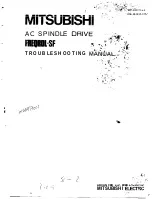
DYNAVERT L
COMMISSIONING
17
Version: 11.10.02
4Bs0503en/002
Commissioning for rated speed
v 3
has been finished. For possibly having intermediate speeds
v 1
or
v 2
the suitable
braking distances have to be parameterized.
2
Trouble shooting instructions
2.1
Fault detection
Internal or external system faults are generally recognized by the following displays or effects:
−
Activation of monitoring devices
−
Clear text display on the inverter display
−
Fuse blown
−
Unsatisfactory drive behavior
2.1.1
Activation of monitoring devices
When the inverter is started it automatically performs various soft- and hardware tests. In addition to this further tests
are continuously performed during operation. If a fault is detected in the software, in the stored parameters, or in the
hardware, the DYNAVERT L switches off electronically and changes to
fault condition
. A fault is indicated by the
fault
LED on the control panel. In addition to this a clear text message is given on the status display and the fault is stored
in the event memory. Potential-free signaling of the
fault
condition is performed by means of the common-fault relay.
2.2
Fault cause
Faults may have their causes in
−
the periphery (connection fault at inverter or motor, connection during operation)
−
the power unit (defective components, loose connections)
−
the control section (incorrect settings, defective components, loose connections)
A distinction should be made as to whether the fault occurs during primary startup or whether it is an operational
fault. In case of primary startup faults often have their origin in periphery faults or in incorrect settings (e.g. missing
check up).
Also faults in the mechanic construction, e.g. not exactly aligned motor/gear or rough running of the tachogenerator
can result in an unsatisfactory drive behavior.







































